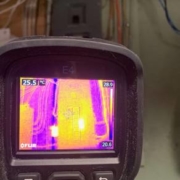Thermal Imaging and the Home Inspection
Most home inspectors today will offer a thermal imaging service of some kind. Thermal Imaging is an extremely useful tool to expand the limited visual scope of a home inspection. It provides us with an extra layer of detail, and the ability to provide extra value to our clients by including a thermal scan as part of every home inspection.
How Thermal Imaging Cameras Work
All objects with a temperature above absolute zero emit infrared radiation. The amount of infrared radiation an object emits increases with temperature. Thermography (also commonly called Infrared (IR) or Thermal Imaging) is a science and a non-invasive method for detecting temperature variations related to heat. While a regular camera basically is a light sensor, capable of creating images by detecting tiny differences in light, an infrared (IR) or thermal camera is essentially a heat sensor capable of creating electronic images based on the interpretation of temperature differences across surfaces.
Detecting Heat Loss

Heating or cooling a building uses large amounts of energy. To be as efficient as possible when using this energy, it must be retained in the building for as long as possible. Missing or improperly installed insulation will allow this
energy to escape, leading to comfort issues, as well as higher heating and cooling costs than necessary.
A thermal imaging camera is an excellent tool for detecting missing insulation that may not be visible otherwise during a home inspection, such as inside walls or in sections of the attic that may not be accessible to the inspector. These cameras are also used in the attic to detect sources of heat loss, such as unsealed openings at the tops of walls, holes or gaps in ductwork, or disconnected exhaust fan ductwork.
 Moisture Intrusion
Moisture Intrusion
Thermal imaging is also a valuable tool for detecting potential moisture issues in a home. Water will retain its temperature longer than most building materials, which will cause it to appear cooler or warmer than surrounding areas in a wall or ceiling. Roof leaks, moisture on ceiling from ice damming, and plumbing leaks can all be revealed by a thermal scan, where they otherwise may not be visible. Temperature anomalies are always checked with a moisture meter to confirm the presence of moisture.
Evaluating Heating and Cooling Systems
Thermal Imaging is used to confirm the correct operation of heating and cooling appliances by confirming that hot or cold air is present at registers, as well as if the temperature of the air at registers matches the intended design of the system . Interior walls and ceilings are also scanned, looking for leaks in ductwork that will reduce the efficiency of the system. A thermal imaging inspection is also a great tool for evaluating the performance of in-floor heating systems.
Electrical Hazards.
During an inspection, these cameras are also valuable tools for detecting hot spots in the electrical panel, outlets, and inside walls caused by overloaded or damaged circuits, beakers, or outlets
As home inspectors, we are typically limited to a “visual only” inspection, meaning we cannot open walls or do any destructive investigation to the home. For this reason, thermal imaging is an essential tool for use during a home inspection, as it adds a completely different visual spectrum to the tools at our disposal, and adds value for our clients, which we love!
home inspectors, we are typically limited to a “visual only” inspection, meaning we cannot open walls or do any destructive investigation to the home. For this reason, thermal imaging is an essential tool for use during a home inspection, as it adds a completely different visual spectrum to the tools at our disposal, and adds value for our clients, which we love!





Leave a Reply
Want to join the discussion?Feel free to contribute!